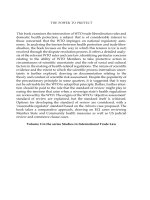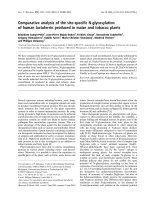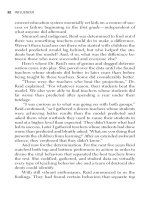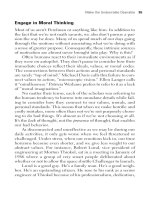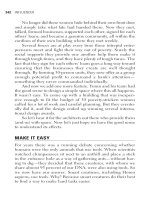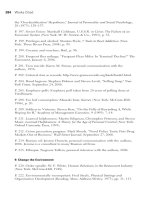Influencer The Power to Change Anything by Kerry Patterson, Joseph Grenny, David Maxfield and Ron McMillan_10 pdf
Bạn đang xem bản rút gọn của tài liệu. Xem và tải ngay bản đầy đủ của tài liệu tại đây (755 KB, 21 trang )
Find Strength in Numbers 179
and men. And yet these people felt unable to exert sufficient
influence to change the behavior they despised. So Japhet gave
them a way. In his own words:
“On the TV program Soul City, we purposefully created a
well-respected teacher, Thabang, who repeatedly abused his
likable wife Matlakala. Viewers—both male and female—
quickly concluded that Matlakala didn’t deserve the abuse as
tradition had often spoken. She was pleasant, easy to get along
with, and nothing more than an innocent victim. Equally
curious, Thabang was mostly a reasonable and good person—
much like themselves.”
Then the writers showed how interested friends and neigh-
bors could be part of the solution. Dr. Arvind Singhal, who
served as a research adviser to Soul City, reports, “On one
episode the neighbors hear Thabang beating poor Matlakala
and they can take it no longer, so they decide to let Thabang
know that his actions aren’t going unobserved. But how?
How could they let Thabang know without being too intrusive?
How could they do it without putting themselves at physical
risk? Saying something directly would be unacceptable and
dangerous.”
Dr. Singhal explains. “To send their violent neighbor the
message that his behavior is neither private nor acceptable, the
neighbors gather outside Thabang’s front door and bang pots
and pans. They don’t say a word; they just bang pots and pans.”
In the program, Thabang becomes embarrassed and begins to
change his behavior.
What happened after that was totally unexpected. People
in several townships across South Africa, upon hearing the
sounds of spousal abuse next door, began to stand in front of
their neighbor’s homes and bang pots and pans.
The power of vicarious modeling had worked its magic.
The message was out. Men would no longer be allowed to
abuse their wives with impunity. Violent behavior, and the col-
lective silence that supported it, were not part of the new norm.
180 INFLUENCER
Here’s the influence takeaway. Japhet realized that if bad
behavior is reinforced by a web of players, all the players have
to be engaged in influencing change. In this particular case,
the neighbors had to help lead the change for good because
neighbors who stood by and allowed obvious abuse to continue
were a big part of the problem.
And that’s also how Mike finally eliminated “project
chicken.” He had first tried to solve the problem by confront-
ing employees like Jess without addressing the role his man-
agers, directors, and a host of others played in the problem.
When he realized what was missing, he took a completely dif-
ferent tack. He asked the training department to teach people
how to hold high-stakes conversations about project problems.
Then he charged every one of his organization’s leaders to be
the teachers. It was a stroke of brilliance that changed every-
thing.
Every two weeks the very manager who had previously sent
subtle signals about suppressing candor taught a two-hour ses-
sion on how to speak up about risky problems. In the first two
sessions Jess listened passively and cynically. By the third ses-
sion he raised a concern with his manager. In the context of
the class, the manager felt a special responsibility to respond
appropriately. By the sixth session many of Jess’s peers had
begun to open up. Within a matter of months powerful new
norms emerged, and Mike’s vital behavior of candor under
pressure flourished. Within a year the organization had
launched two product releases on time and on budget, and
morale was at an all-time high.*
To see how the power of social capital can apply at home,
let’s return to our friend Henry as he continues his lifelong
quest to eat healthily and keep his weight down. He’s learned
that when it comes to coworkers, friends, and family members,
*For more information on this and other case studies, visit www.vitalsmarts.com/
corporatecasestudies.aspx.
Find Strength in Numbers 181
most are full-out disablers, not enablers. Instead of acting like
friends, they act like accomplices in the crimes against his body.
They take Henry out to fancy restaurants, eat fatty and delicious
food in front of him at work, give him gifts of the very food he
loves but shouldn’t eat, stock the pantry chock full of all the
wrong ingredients, and so on.
In fact, when it comes to losing weight, Henry can’t think
of anyone who is enabling him in any way. One day when he
asked his wife to stop buying bags of chocolate candy, she actu-
ally laughed out loud. She loves candy, buys candy, eats candy,
and never gains a pound, so why shouldn’t she buy candy?
But Henry knows it’s hard to go it alone. “Hey, look at me.
I live here in the apartment with you. I smell all that delicious
chocolate, and it drives me crazy!”
And it wasn’t just his olfactory powers that clued Henry in
about the importance of enlisting others’ help. He had recently
read a study (conducted by our friend Albert Bandura) about
research subjects who were trying to lower their cholesterol. As
both Henry and Albert suspected, participants routinely
achieved greater reductions in their cholesterol when their
spouses took part in the program.
So Henry has to find a way to step up to his disablers and
ask them to become enablers. This means that Henry will have
to talk to others in a way that creates genuine dialogue rather
than resistance and recrimination.
When You Can’t Succeed on Your Own
The poet John Donne was right: No man is an island. When
the people surrounding you are causing or contributing to the
problems—playing the role of disabler rather than enabler—
fight the urge to attack your detractors for their contribution to
your pain. Instead, co-opt them. Turn a me problem into a we
problem. Build social capital in order to resolve persistent and
resistant behaviors.
182 INFLUENCER
Interdependence. When a vital behavior requires several peo-
ple to work in concert—where no one person can succeed on
his or her own—you have to develop people’s ability to work
as a team. There was a time when highly skilled craftspeople
worked alone producing pots, candles, jewelry, and the like.
But today corporate success often depends on experts who are
at least as specialized as their predecessors, but who rely on one
another to complete their tasks.
For instance, a typical software development team consists
not only of code writers but also of designers, marketers, writ-
ers, and salespeople. At various stages in the development, all
have to connect, bring their piece of the project online, and,
at the interpersonal level, find a way to collaborate. Leaders
who fail to appreciate this concept are regularly disappointed
when their influence efforts bear no fruit.
We (the authors) once worked with a production team that
had decided to lower costs by shifting to just-in-time inventory.
This meant that no longer would the company maintain a stock
of parts and work-in-progress as the product made its way
through the production line. One expert would hand his or her
finished work to the next expert instead of placing it in a stack
that the next person would get to at his or her leisure. This new
design, of course, called for impeccable timing (each person’s
job needed to take the same amount of time as the person’s
before and after him or her). It also called for genuine collab-
oration. Any one person could slow down, speed up, take an
unscheduled break, or fail to meet a quality standard, causing
the previous and next person fits.
When we arrived to help with the project, the company had
learned that the old style of stacking expensive inventory
between employees had masked the workforce’s inability to
cooperate. Now that employees were immediately dependent
on the person before and after them, they were constantly bick-
ering, complaining, and asking to change positions in the line.
Supervisors would routinely intervene to help their direct
Find Strength in Numbers 183
reports work through problems, but they ended up spending
most of their time refereeing heated arguments.
It turns out that the company wasn’t prepared to shift to a
just-in-time system because it didn’t possess the social capital
to collaborate. When executives purposefully built interde-
pendence into the work design, it quickly revealed that employ-
ees lacked interpersonal problem-solving skills along with the
ability to hold one other accountable. Working in isolation had
atrophied their ability to interact effectively. No longer did
employees “work and play well” with their friends.
The company was unable to implement the new inventory
system until each employee had been trained in interpersonal
problem solving. Interdependence calls for individuals to share
ideas, provide materials, lend a hand, subordinate one’s per-
sonal needs to the needs of the group, and otherwise willingly
and ably collaborate. Leaders who don’t continually help inter-
dependent employees learn new and better ways to work in tan-
dem tend to routinely suffer from rivalry, and are never able to
make full use of their valuable social capital.
Novelty. Tanika’s group demonstrates another circumstance
that calls for the power of social capital. Tanika and the other
members of her borrower group were certainly not specialists,
and they faced problems that were completely new to them.
Fortunately, the toys-for-hair plan the five came up with grew
out of the best thinking of the group. No one person had exactly
the right idea, but as one partial idea was added upon and then
changed again, each person helped create a strategy that, if left
to her own devices, none would have invented.
When facing changing, turbulent, or novel times—calling
for novel solutions—multiple heads can be better than one. By
demanding that no budding entrepreneur work alone, Dr. Yunus
ensures that his microcredit clients always work in teams, think
in teams, and meet every single week and brainstorm as teams.
Grameen Bank counts on synergy through forced interaction.
184 INFLUENCER
Risk. As you might expect, among all the influencers we have
studied, those who faced the biggest risks also drew most heav-
ily from the power of social capital as a means of reducing that
risk. Toward the top of this list, of course, would be Dr. Silbert,
whose job it is to transform hardened criminals into produc-
tive citizens. Think of what Silbert’s wards do as a matter of
their daily work, and you’ll appreciate just how much risk she
and her organization face.
Every day about a hundred of Silbert’s San Francisco resi-
dents invade people’s residences across the Bay Area and
remove their valuables. This is something many of them did
before joining Delancey. The difference now is that they are
doing so as part of the Delancey Moving Company. That’s
right, people who had once made a living moving furniture
and other goods illegally are now doing so legally. You’d
think that this business strategy was far too risky, given the
employees’ job histories. Nevertheless, every single valuable
Delancey movers remove shows up at the new residence.
Delancey is the largest privately owned moving company in
the Bay Area for a good reason. The company has never had a
loss or theft. Imagine what would happen if even one pearl
necklace came up missing? Delancey’s reputation would be
lost, and the moving company along with its 100 jobs would
simply disappear. In spite of huge risk, Delancey has no
problems.
Equally astounding is the fact that in the Delancey restau-
rant, residents still reeling from alcohol or drug withdrawal
serve alcohol to customers as part of their daily job. Hearing
about this obvious incongruity for the first time, we asked
Silbert how she deals with “relapses.” Without hesitation, she
answered, “We don’t have relapse.” When we pressed her, she
thought back to the last instance of abuse and acknowledged
that a year earlier one person had “gotten dirty.” To fully appre-
ciate what this means, we need to consider that the average
rehab program has a very low success rate.
Find Strength in Numbers 185
Silbert sends criminals into people’s homes, and she asks
alcoholics to serve drinks—with almost no problems. When
you ask her why her influence strategy succeeds, she explains
that a key lies in the complex, pervasive, and powerful social
system of Delancey. The organization does not have a single
in-house professional, but it does have a great deal of social cap-
ital. Delancey relies on a web of helping relationships that
Silbert has constructed for over 30 years.
Here’s how she draws on the power of social capital as a
means of supporting vital behaviors. Silbert structures the
entire Delancey experience around residents giving each other
instruction, mentoring, and guidance. That means that a resi-
dent who has been onboard for a single day is likely to be asked
to assist someone who has just arrived. And despite the fact that
a resident may have shown up at the front door hung over, une-
ducated, and skilled only in criminal behavior, he or she will
eventually earn the equivalent of a Ph.D. in mentoring, coach-
ing, and teaching—or nobody would make it out alive.
In Silbert’s words, “You learn a little and then teach it to
someone else—‘Each one teach one.’ For example, you’re at
Delancey a hot minute and someone newer than you comes
in. So someone says to you, ‘Do me a favor, take him under
your wing.’ From that point on people talk with you more about
how you’re doing with the guys under you than about yourself.”
To ensure that individuals assist one another, Delancey is
structured with one goal in mind. From the moment a resident
arrives at Delancey—frightened and suspicious—he or she is
immersed in a culture and language system designed to max-
imize peer support. If you were a resident, here’s how you’d be
enriched with social capital.
When you first show up, you’re assigned to a dorm of nine
individuals of different races. Next, you’re placed in what is
known as a “minyan.” A minyan is made up of ten people from
different dorms. The word minyan originates from Jewish tra-
dition and refers to a congregation consisting of 10 adults. A
186 INFLUENCER
full minyan is required to be present before public services can
be held. So, the Delancey version of a minyan is a self-support-
ing group that’s able to do what residents would be unable to
do on their own. At Delancey, minyans practically print social
capital.
Minyan leaders take primary responsibility for residents’
growth, needs, and supervision. Minyans, in turn, are super-
vised by a “barber.” (A good bawling out on the street is some-
times referred to as a “haircut.” Hence, the title barber goes to
those whose job it is to ensure that everyone in the minyan is
challenging everyone else.)
The use of social capital takes on still more forms. For
example, residents work for crews with crew bosses who are also
peers. The average person arrives with a seventh-grade educa-
tion, and each is required to leave Delancey with at least a high
school equivalency certificate. And Delancey achieves this
amazing result without hiring a single professional teacher.
They build social capital by tutoring each other.
To see how all this coaching, teaching, modeling, and tutor-
ing plays itself out, consider the field of romance.
“We’re not healthy,” our Delancey resident James admits.
“We shouldn’t be in relationships until we can see the thing is
more than sex. We tend to just say, ‘The hell with it!’ when the
relationship gets tough.”
So to prepare to go on dates (something they’re not allowed
to do for at least six months), residents attend couples’ groups
which, as you’ve probably guessed, are taught by resident cou-
ples who have been dating slightly longer than the new students.
The more seasoned couples teach others how to behave on dates
as well as how to talk about what’s working and what isn’t. And
guess who will be going along with each new couple on their
first few dates. A chaperone who is assigned by the barber to
keep the two on the straight and narrow.
This is but a small sampling of how an organization that
has virtually no professional resources invests in social capital
Find Strength in Numbers 187
as the primary asset for changing people’s behavior—and lives.
Now, if a philanthropist left a billion dollars to Delancey so that
the institution could afford to hire professional teachers, coun-
selors, and coaches, do you think Dr. Silbert would allow it?
Of course not. By helping others, residents help themselves
even more. Teachers learn more than students, mentors more
than mentees, and trainers more trainees, so why restrict all this
important learning to outside professionals who have already
been to school?
At the business level, more than one organization is begin-
ning to understand how to reduce risk by making better use of
social capital. For example, venture capitalists in Silicon Valley
create “business incubators” as a way of helping new businesses
survive the risky start-up phase. These are a system through
which specialists of all types freely offer expertise to companies
when it’s most needed.
From a personal career standpoint, the need to build social
capital by connecting with others has never been greater. Tom
Boyle of British Telecom coined the expression NQ, or network
quotient, to highlight the importance of a person’s ability to
form connections with others. He argues that from a career
standpoint a person’s NQ is now more important than his or
her IQ. Since you can’t know everything, it’s essential that you
find people who can make up for your blind spots. A whole host
of recent studies reveals that today’s most successful employ-
ees have networks of people they can go to for expertise, as well
as networks of people they can trust with sensitive requests.
Successful people not only refuse to see themselves as islands,
but they carefully reduce their personal vulnerability by ensur-
ing that they’re valued members of hyperconnected networks.
All these examples deal with the same problem. Chang-
ing, complex, turbulent, and risky times require multiple heads
to come up with creative solutions that no one person could
ever invent. So take your lead from Dr. Yunus. When problems
call for creativity and multiple views, place people in teams. To
188 INFLUENCER
make the best use of your existing human resources and dra-
matically lower your risks, take your lead from Delancey by
turning your more experienced employees into coaches, train-
ers, instructors, and mentors.
Blind Spots. Perhaps the most obvious condition that demands
social support as a means of influencing vital behaviors comes
with the need for feedback that can be offered only by a pair
of outside eyes. Anyone who has ever tried to learn tennis on
his or her own and then gone head-on with someone who has
spent a similar amount of time practicing with the aid of a
coach quickly learns that real-time feedback from an expert
beats solo practice any day. This being the case, you’d think that
most people would turn to coaches to help in key areas of their
lives, but they don’t. Only a few ask for feedback outside of
sports arenas.
But there are exceptions. For example, in health care,
where doctors are required to insert tubes in people’s hearts and
perform other such high-stakes practices, professionals long ago
learned the power of real-time coaching. In many instances,
physicians aren’t allowed to merely watch others perform a
detailed and dangerous procedure before they try it on their
own. Instead, they must attempt the delicate procedure while
a coach provides immediate feedback on what’s working and
what isn’t.
When it comes to business and other lower-risk settings,
leaders rarely think of using real-time coaches. Some of today’s
companies provide their leaders with call-in advisers who dis-
cuss what happened yesterday when the leader faced a chal-
lenge and didn’t do all that well. But few provide real-time
coaching. This should change.
For example, when we (the authors) worked with Lauren—
a rather vibrant executive who was a terrible speaker—we pro-
vided her with a speech coach. It was amazing to watch someone
once described as having “the uncanny ability to whip a crowd
into a nap” be transformed into a solid speaker in a matter of a
Find Strength in Numbers 189
few hours. Lauren didn’t take a course or read a book; she merely
practiced giving a speech while receiving immediate feedback:
“Pick up the speed by 10 percent.” “Pause after the word ‘suc-
cessful.’ ” After four hours of guided instruction, Lauren learned
what might have taken months without feedback.
Since you’re on the wrong side of your eyeballs, you can’t
always see exactly what it is that you’re doing that works or
doesn’t work. So invest in still another form of social capital:
Seek real-time feedback from an expert.
Group Solidarity. In a parable by William Forster Lloyd pub-
lished in 1833, we first hear of a problem that is now known as
the “tragedy of the commons.” The parable describes how a
town allowed farmers to graze livestock at will on common
soil—soil often owned by nobility. This well-intentioned prac-
tice eventually led to a public disaster. The more successful a
farmer became, the more sheep he grazed, until eventually
there were so many sheep grazing on the land that “the com-
mon” was destroyed. What was good for the individual farmer
was bad for the collective whole.
You might have faced a similarly constructed scenario. For
instance, after plodding along for an hour in stop-and-go traf-
fic, you come across the cause of the hold-up. You discover that
a large box lies in one lane, causing the snarl. On the one hand
what’s good for you—zooming off immediately—is bad for
everyone who follows. On the other hand, if you were to sac-
rifice your own interest and step out of the car and remove the
box, everyone else would benefit.
Under these conditions, individuals have to learn how to
invest in one of the most powerful forms of social capital—soli-
darity. We must give ourselves up to the larger cause and act for
the good of everyone else, or the plan will fail. For instance, we
(the authors) were once charged with creating a leadership class
that taught newly appointed frontline supervisors how to hold
their direct reports accountable. To create the course, we looked
for positive deviance. We watched those who succeeded where
190 INFLUENCER
others failed in action, learned what they did, and then included
their unique skills in an accountability class.
After completing the course, all the graduates were asked
to put into practice what they had just learned by talking to peo-
ple who broke rules, violated procedures, or otherwise behaved
badly. But a few didn’t put their new skills into practice. These
“late adopters” waited to see if their colleagues were going to
step up to the challenge before they gave their new tools a trial
run. The majority who did confront their direct reports about
deviations were soon ridiculed for being too tough. Hourly folks
pointed to the supervisors who weren’t setting the same stan-
dards for their employees and concluded that their own bosses
were unfair or hard-nosed. Eventually everyone stopped apply-
ing what he or she had studied.
We learned from this incident the power of solidarity. From
that point on we secured the promise of every supervisor that
he or she would step up to problems before we sent anyone into
action. With that particular change project, asking employees
to toe the line turned out to be an all-or-nothing deal.
To see the importance of solidarity on a much larger scale,
let’s look at how our friend Dr. Wiwat from Thailand exploited
social capital to help stop the spread of HIV/AIDS. After fail-
ing to make a dent in the problem using traditional influence
methods, Wiwat took a much more direct approach. Shutting
down the sex industry in Thailand was the ideal, but leaders
were unable to do so, and the vicious virus was spreading at
unprecedented rates. So leaders turned their attention to stop-
ping the spread of HIV/AIDS. Since almost all the new cases
were coming from sex workers who weren’t protecting them-
selves or their clients, Wiwat started a campaign of solidarity.
In Wiwat’s view, one group of people—sex workers—could
bring the spread of HIV/AIDS to a halt, but it would have to be
done as a group. When a client offered money for sex and the
sex worker demanded protection (a solution to the spread of
AIDS), more often than not the client would simply go elsewhere.
Find Strength in Numbers 191
But what if every worker demanded protection and always
refused the financial incentive? Then there would be no place
where clients could find sex workers who offered unprotected
sex and eventually every client would practice safe sex, thereby
stopping the spread of AIDS. But once again, this plan called
for an all-or-nothing deal. If one sex worker broke ranks or one
brothel eased its demands, the game would be off.
To ensure that everyone complied, Wiwat held a meeting
to which he invited all sex business owners. Then he held a
meeting for all their workers. In both forums he explained the
economics of why every single person had to participate in the
plan or AIDS would eventually kill them all along with their
businesses. He then informed them of HIV growth rates and
detailed what would happen if any individual or establishment
refused to sign up for the program.
Eventually, when every worker bought into the plan and
the entire population banded together by demanding pro-
tection, compliance rates increased from around 14 percent
to over 90 percent. As a result of demanding solidarity and
providing needed social support, an estimated 5 million peo-
ple have been spared the horrific consequences of contracting
HIV/AIDS in Thailand.
What role might solidarity play closer to home? When
studying parenting, it doesn’t take long to uncover the simple
yet important notion that, with effective parents, no means no.
Effective parents help bring predictability into a child’s turbu-
lent life by letting him or her know that parents’ word is their
bond. If a child hits her sister, she’ll pay a consequence. If a
teenager comes home after curfew, it’ll come with a cost. With
two parents in the home, the expectation that no actually
means no can of course be achieved only when both parents
stand unified, shoulder to shoulder. Otherwise, the child plays
one parent off the other, and anarchy prevails. When it comes
to disciplining children—as is the case with many profound
and pervasive problems—solidarity rules.
192 INFLUENCER
SUMMARY: SOCIAL ABILITY
In an interdependent, turbulent world, our biggest oppo-
nents—the mortal enemy of all families, companies, and com-
munities—may well be our inability to work in concert. Since
rarely does any one of us have all that’s required to succeed with
the complex tasks we face every day, we desperately need to
build social capital.
However, that’s certainly not the message we’ve been fed
for years. The movie and TV heroes of the last half century
have fought the enemy within—the big bosses, the establish-
ment, “the man.” This constant celebration of the rugged indi-
vidualist has had an enormous dampening effect on people’s
willingness to draw on others to enable change.
Savvy influencers know better than to turn their backs on
social capital. They’re quick to consider what help, authority,
consent, or cooperation individuals may need when facing risky
or daunting new behaviors. Then they develop an influence
strategy that offers the social capital required to help make
change inevitable.
193
8
Design Rewards and
Demand Accountability
STRUCTURAL MOTIVATION
I can take any amount of criticism,
so long as it is unqualified praise.
—Attributed to Noel Coward
Design
Rewards and
Demand
Accountability
Change the
Environment
Harness
Peer Pressure
Find Strength
in Numbers
Make the
Undesirable
Desirable
Surpass
Your Limits
MOTIVATION
PERSONAL
SOCIAL
STRUCTURAL
ABILITY
Copyright © 2008 by VitalSmarts, LLC. Click here for terms of use.
194 INFLUENCER
S
o far we’ve explored both personal and social influence.
Now we step away from human factors and examine how
to optimize the power of things such as rewards, perks,
bonuses, salaries, and the occasional boot in the rear.
CHOOSE EXTRINSIC REWARDS THIRD
We’re about to step on dangerous ground. Stories of well-
intended rewards that inadvertently backfire are legion. The
primary cause of most of these debacles is that individuals
attempt to influence behaviors by using rewards as their
first motivational strategy. In a well-balanced change effort,
rewards come third. Influence masters first ensure that vital
behaviors connect to intrinsic satisfaction. Next, they line
up social support. They double check both of these areas
before they finally choose extrinsic rewards to motivate be-
havior. If you don’t follow this careful order, you’re likely to be
disappointed.
This particular concept came to the world’s attention with
a nursery school study that sent out a warning that won’t soon
be forgotten. In fact, in 1973 when Dr. Mark Lepper and his
colleagues examined the effects of rewarding children (giving
them their favorite snack) for engaging in activities that they
already enjoyed (playing with their favorite toy), change agents,
coaches, parents, and leaders all took note.
Dr. Lepper revealed that rewarding people for engaging in
an activity that is already satisfying may work against you.
Instead of increasing the frequency of the activity, once the
reward is taken away, subjects may do less of it. At least, once
the favorite treat was taken away from the Bing Nursery School
kids that Lepper studied, they played with their favorite toy less
often than they played with it before they were rewarded for
doing so.
Think of the implications. You want your daughter to learn
to love reading with the same joy and fervor you and your
Design Rewards and Demand Accountability 195
spouse have. You notice that she’s starting to pick up the habit
on her own, so you decide to reinforce it. To encourage her,
you create an incentive program. Every time she picks out a
book on her own and reads it, you give her five dollars. She
loves the plan, starts reading more, and after a while spends her
earnings on a new video game for her latest game system. In
fact, it’s not long until she’s able to buy several games, for which
she thanks you profusely.
After a while you think that you’ve rewarded reading enough
and that the pure pleasure of soaking in the words of some of
the world’s best authors has become its own reward. So you pull
away the incentive. Surely your encouragement has helped your
daughter learn to love reading good books even more. Most cer-
tainly she’ll now snuggle up with her favorite author’s latest work
without any encouragement from you.
But your plan backfires. The minute you stop paying your
daughter for reading, she turns to her video game system and
reads less than she did before you started the incentive program.
Apparently she has learned to earn money to purchase video
games, and the incentive you tried didn’t leave the impression
you wanted. She’s just like those nursery school kids. Where
did you and Dr. Lepper go wrong?
The explanation for this phenomenon, known as “the over-
justification hypothesis,” suggests that if people receive rewards
for doing something they initially enjoy, they conclude the
same thing an outsider watching them in action might con-
clude. When thinking about what’s happening, humans recog-
nize that they’re doing something and getting paid a special
bonus for doing it. They conclude that since they’re being
rewarded for the task, it must not be all that satisfying (why else
would someone offer a reward?), and therefore they’re doing it
for the bonus. And now for the dangerous part. Once the
reward is removed, the person believes that the activity isn’t as
much fun as he or she judged earlier, so he or she does it less
often.
196 INFLUENCER
Generally people are perfectly happy getting rewarded for
something they already enjoy. For example, imagine that you
absolutely love playing the harp (a hobby you picked up in your
forties) and your next-door neighbor asks you to play at his son’s
wedding reception—for a nice fee. You love playing, you love
the attention, and you are really psyched about getting paid for
doing something you already love doing. You can’t believe your
luck. For you, getting paid to do what you love doing doesn’t
diminish your affection one tiny bit.
Sometimes, however, making use of extrinsic rewards can
be complicated. As Dr. Lepper learned, not every reward has
its desired effect. Sometimes extrinsic programs can com-
pletely backfire and serve as a punishment. For example, a com-
pany’s “Employee of the Month Program” is supposed to give
special attention to people who have done something, well, spe-
cial. They’re singled out at an all-hands meeting and are given
a plaque.
Comedian Demetri Martin summed up the way a lot of
employees feel about such programs when he said, “I think
employee-of-the-month is a good example of when a person
can be a winner and a loser at the same time.”
To many employees, being singled out in front of and com-
pared to peers might not be all that rewarding. It could be just
the equivalent of saying, “Congratulations! Here’s a hundred
dollars, a beautiful plaque with your name engraved on it—and
four weeks of unrelenting ridicule from your coworkers!”
Organizational scholars have long found that many employ-
ees leave corporate award ceremonies not motivated and
excited as intended, but with exactly the opposite reaction.
They exit demotivated and upset because they themselves
weren’t honored. In fact, many see the whole ceremony as a
sham. Interviews reveal that typically half of those who attend
corporate awards programs believe that they were far better
qualified than the person who was honored but that they
didn’t get picked for political reasons.
Design Rewards and Demand Accountability 197
And it’s not just token awards that can go amiss. You could
fill volumes with stories of how carefully considered incentive
schemes have run amok. One hospital, for example, found that
anesthesiologists who were paid based on personal production
were less willing to jump in and help one another when some-
one else’s patient was reacting badly.
Consider a couple of the former Soviet Union’s attempts to
dabble in incentive schemes. In the energy sector, rubles were
literally being thrown away in the search for oil reserves because
Soviet workers received bonuses according to the number of feet
they drilled. It turns out that it’s far easier to drill many shallow
holes than to drill a few deeper ones—which is exactly what
happened. Instead of following the geological advisories to drill
deep to find existing reserves, workers were happy merely pok-
ing the surface over and over—turning up very little oil. After
all, it’s what they were rewarded for doing. Similarly, in a Soviet
nail factory, leaders who paid bonuses based on the total weight
of nails produced did see weight production shoot up. Un-
fortunately, it climbed as workers produced exactly the same
number of nails as they had before—the nails were just bigger.
Not pleased with the increase in the size of the nails, leaders
began offering rewards based on the number of nails produced.
Once again, the incentive worked and production shot up, but
the factory produced only very small nails.
One woman we worked with—a manager at an inter-
nationally renowned company—decided that her employees
weren’t as innovative as they needed to be, so she instituted a
simple suggestion program. What could be more innocent? To
encourage creativity, she asked each work group to meet for at
least a half hour per week to brainstorm new work methods,
solutions to long-standing problems, and possible new prod-
ucts. To put teeth into the new program, she put together a
committee that reviewed submissions and then awarded cash
prizes to employees who came up with ideas that were judged
as “real moneymakers.”
198 INFLUENCER
Within a few months the cash-for-ideas program had com-
pletely broken down. In fact, members of one work group
ended up beating up one of their own team members as a result
of the program. It turns out the team came up with a really good
idea, and Charlie, the aforementioned team member, promised
that he’d take care of the paperwork. He then submitted the sug-
gestion under his own name and kept the $5,000 bonus for him-
self. When his teammates found out about the deception, first
they confronted him, then someone shoved him, then a melee
broke out, and Charlie ended up in the emergency room.
To avoid further injuries, the owner did away with the
incentive program. Of course, she still invited suggestions, but
none came in. Employees now believed that she was shorting
them by asking for ideas without offering incremental pay. She
had hoped to use the suggestion program to stimulate innova-
tion, but found that by paying people for their thoughts, she
had inadvertently sent the message that making suggestions was
outside a person’s normal job requirements. Now employees
believed that if they came up with a good idea, they deserved
to be paid a bonus. Otherwise, they were being exploited.
What’s a leader to do?
USE INCENTIVES WISELY
Remember the principle we started with. Don’t use incentives
to compensate for your failure to engage personal and social
motivation. Nevertheless, let’s be clear. Influence masters even-
tually use rewards and punishments. For instance, if you don’t
repay a loan to Muhammad Yunus’s Grameen Bank, your bor-
rower group has to pay it back for you. And remember, people
there know where you live! If a person in a rural African vil-
lage discovers that his neighbor is hiding a Guinea worm
infection—and if that person brings it to the attention of vil-
lage leaders—the good citizen is given an attractive T-shirt
(emblazoned with a Guinea worm logo).
Design Rewards and Demand Accountability 199
So, the question is, how do you use incentives wisely?
Take care to ensure that the rewards come soon, are gratify-
ing, and are clearly tied to vital behaviors. When you do so, even
small rewards can be used to help people overcome some of the
most profound and persistent problems. For example, Johns
Hopkins Hospital completed a study of alcoholics who had been
admitted to the hospital to, of all things, drink alcohol—but only
in moderate quantities. The idea of the project wasn’t to encour-
age the subjects to climb on the wagon or to go cold turkey, but
to learn how to drink in moderation.
To influence patients’ behavior, each day staff members
determined privileges on the basis of how much alcohol the
patients consumed. If they drank too much, they were given
pureed food instead of the normal offering. Their amount of
consumption also affected phone privileges, visiting hours,
and so on. When compared to control patients who were sim-
ply told how much to drink with no incentives, experimental
subjects were 60 percent more likely to reach their target con-
sumption level.
When you first hear that a simple incentive such as phone
privileges can help patients break free from something as pow-
erful as the steel grip of alcoholism, it’s a bit hard to believe.
Nevertheless, this example pales in comparison to the work of
Dr. Stephen Higgins, who routinely uses vouchers to help
direct the behavior of cocaine addicts. Cocaine addicts typically
fail to make progress in recovery programs because they quit
before the program starts to take effect. With Dr. Higgins’s
voucher system, outpatients are required to submit a urine sam-
ple three times a week. If all three samples test negative, the
subjects receive a bonus voucher that they can exchange for
goods and services provided by the research staff.
With something as tremendously addictive as cocaine,
you’d expect that a simple voucher that could be traded only
for a rather small prize wouldn’t have much of an effect. In Dr.
Higgins’s own words: “It surprises many people that a stack of

